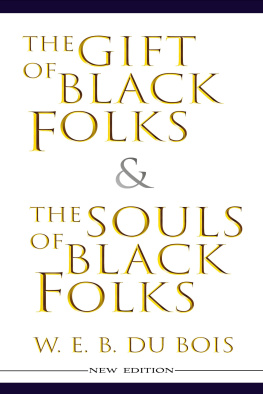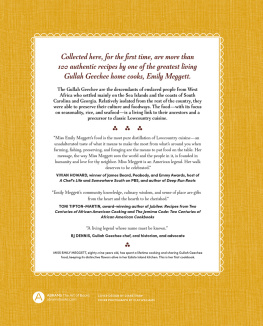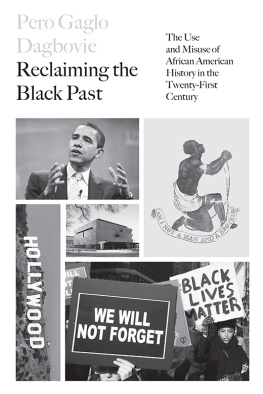2017 The University of North Carolina Press
All rights reserved
Manufactured in the United States of America
Set in Quadraat by Tseng Information Systems, Inc.
The University of North Carolina Press has been a member of the Green Press Initiative since 2003.
Cover illustration: Christmas at the Big House [Howard Coffins home on Sapelo Island]1913. Courtesy of the University of Georgia Marine Institute.
Library of Congress Cataloging-in-Publication Data
Names: Cooper, Melissa L., author.
Title: Making Gullah : a history of Sapelo Islanders, race, and the American imagination / Melissa L. Cooper.
Other titles: John Hope Franklin series in African American history and culture.
Description: Chapel Hill : The University of North Carolina Press, 2017. | Series: The John Hope Franklin series in African American history and culture | Includes bibliographical references and index.
Identifiers: LCCN 2016042809| ISBN 9781469632674 (cloth : alk. paper) | ISBN 9781469632681 (pbk : alk. paper) | ISBN 9781469632698 (ebook)
Subjects: LCSH : GullahsGeorgiaSapelo Island. | African AmericansGeorgiaSapelo IslandHistory. | Gullah Geechee Cultural Heritage Corridor.
Classification: LCC F 292. M 15 C 66 2017 | DDC 975.8/73700496073dc23 LC record available at https://lccn.loc.gov/2016042809
Illustrations
Young Fred Johnson, Howard Coffin, and President Coolidge
Sapelo road builders
Sapelo woman fanning rice
Sapelo women and girls
The Johnsons in National Geographic Magazine
Isaac and Naomi Johnson in National Geographic Magazine
Hettie Walker and Ada in National Geographic Magazine
Lydia Parrish and Susyanna
Isaac and Naomi Johnson
Lorenzo Dow Turner
Mary L. Granger at Barnard, 1921
Katie Brown in Drums and Shadows
Shad Hall in Drums and Shadows
Making Gullah
Prologue: The Misremembered Past
For the past twenty years, on the third Saturday in October, scores of visitors have flocked to the ferry headed for Sapelo Island, Georgia, to partake in the annual Cultural Day festivities. The fund-raising festival hosted by the Sapelo Island Cultural and Revitalization Society always attracts tourists who eagerly anticipate an encounter with real Gullah people and folk culture. Visitors look forward to observing ring shout and Gullah dialect performances, purchasing handwoven sweetgrass baskets and homemade rag dolls, and sampling the Islanders cuisine on the grounds of the old Farmers Alliance Hall.
One of the largest barrier islands in the region, Sapelo is comprised of more than fifteen thousand acres of lush landscape, accented by towering trees draped with Spanish moss, expansive marshlands, thick patches of pinewoods, and white sand beaches bordered by billowy sand dunes. The skeletal remains of slave cabins can be found on the grounds of what was once one of the islands smaller plantations, and the mansion that was a seasonal home to the millionaires who occupied the island stands on the exact spot where Thomas Spaldings big house stood during slavery days. To date, the island can be reached only by ferry and has just a handful of paved roads, a tiny post office, one gas station, and a small general store nestled in the heart of the islands only surviving black settlementHog Hammock. Fewer than fifty descendants of the blacks enslaved on the island continue to live, year round, in Hog Hammock. They share Sapelo Island with transient groups of researchers stationed at the Marine Institute on the islands south end and with tourists and regular weekend visitors.
When Cultural Day visitors arrive on the island and walk the docks rickety planks as the balmy air engulfs them, they frequently report feelings of being transported back in time. Many of Sapelos visitors are lured to the island by stories about a place and a people that remain unchanged despite the passing years. As a result, a good number of Sapelos visitors hope to catch a glimpse of a specter of the mystical-magical blacks who, in their relative isolation, managed to exist suspended in time.
But Sapelo Islanders history is not the tale of an unchanging, time-forgotten folk. In fact, every aspect of life on the island has been shaped by the dynamic convergence of a host of shifts and events. The islands undeveloped landscape, the fact that the island has fewer than fifty year-round black residents, and the very notion that Sapelo Islanders are unique Gullah folk can all be attributed to transformations in social, economic, and political realities. However, these less romantic truths are largely absent from the picture of Sapelo Islanders that most visitors imagine. Even though so much of the way that Sapelo Islanders are envisioned is focused on the past and on their African ancestors, very little attention is paid to the way that the long history of blacks on the island has shaped the present.
If the scores of tourists who approach Sapelos shores each year knew the history of Sapelo Islanders, their view of the people and the place would likely change. To start, their fantasies about a nebulous mass of enchanted African ancestors whose traditions have been cited as evidence of heightened retention of African cultural traits among their descendants would quickly fade, and images of hundreds of defiant captives enslaved on the island would take their place. From the first group of Africans brought to the island by Patrick Mackay in 1762 and those who slaved for John McQueen, to the Africans brought to the island in 1791 by the wealth-seeking partners of the French Sapelo Company; from the hundreds of blacks enslaved by famed cotton planter Thomas Spalding to the Africans who came to the island as property of ship captain and slaver Edward Swarbeck and those brought from St. Domingo by their master John Montalet in the wake of the Haitian Revolution in 1805Sapelo Islanders ancestors had always been engaged in temporal struggles for their freedom and autonomy.
Most of the stories that attract Sapelos tourists divorce the Islanders history from the horrors of chattel slavery. But the island that is now considered a veritable paradise was once the site of incredible suffering. The first groups of blacks enslaved on Sapelo endured whippings, iron collars, weighted ankles, and punishments that included being exiled on the uninhabited neighboring Blackbeard Island, without shelter or rations.
Some Sapelo tourists are familiar with Spaldings captive Bilali Mohammed and are taken by tales about the Muslim from Futa Jallon who is said to have held tight to his fez, prayer rug, and leather-bound journal and was rumored to have been buried with a Koran on his breast. In their imaginations, Mohammeds commitment to Islam simply serves to color the African character of the island.
Romantic accounts that describe Sapelo during the antebellum years highlight the fact that Spaldinga descendant of Georgia settlers who protested the introduction of slavery to the colonyencouraged his captives to establish independent slave communities as evidence of his benevolent spirit.
When Spalding died, many of the hundreds of captives that he deeded to his children took advantage of the sectional conflict that threatened to destroy the empire that he built to secure their freedom.







